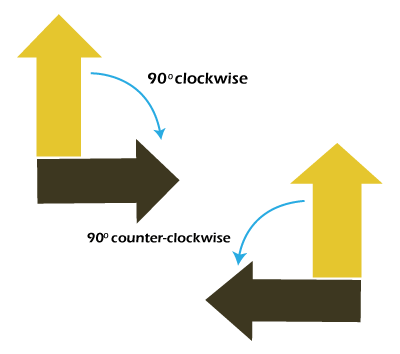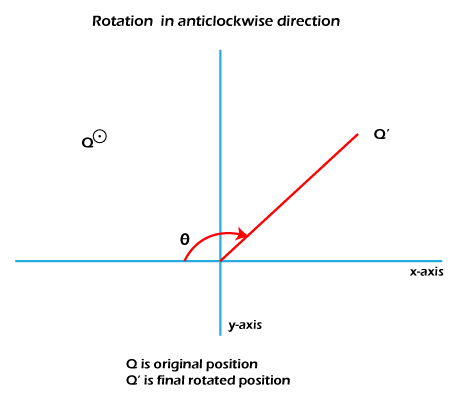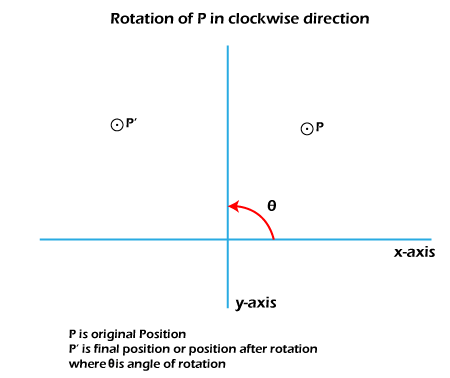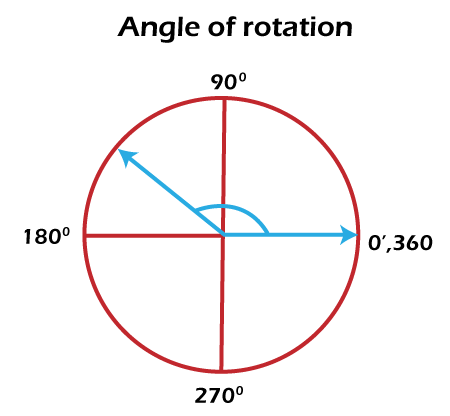Angle of rotationIn this article, we will discuss the Angle of rotation. Before discussing the angle of rotation, let's first discuss rotation. RotationIt is defined as the process of changing the object's angle. For rotation, we have to specify the angle of rotation and rotation point. Rotation point is also called a pivot point. Examples of rotation - In real-life, various examples of rotation such as the earth rotates on its own axis, globe of map that rotates on its axis, and many more. Types of Rotation:

Rotation can be clockwise and counter-clockwise. The positive value of the pivot point (rotation angle) rotates an object in a counter-clockwise (anti-clockwise) direction. 
The negative value of the pivot point (rotation angle) rotates an object in a clockwise direction. 
Clockwise rotation is the negative rotation. As an instance, the counter-clockwise rotation of 310 degrees can also be called as the -50 degree. It is because 310 degrees + 50 degrees = 360 degrees that makes a complete rotation. Now, let's see the angle of rotation. Angle of rotationThe angle of rotation is the measurement of the amount of angle through which a figure is rotated about a fixed point, i.e., the center of the circle. It is also called as "order of symmetry". 
It is possible to rotate different shapes by an angle around the center point. In 3D shapes, an object can be rotated about an infinite imaginary lines or rotational axes. Rotations along the x-axis, y-axis, and z-axis are called as the principal rotations. NOTE: A complete rotation about the center point is = 1 turn, 360°, or 2π radians.Once the center of rotation is calculated, then we can determine the angle of rotation by using the following listed ways -
Properties of angle of rotationIf angle of rotation is denoted by AOF(), then -
Let's see a brief description of rotational symmetry with angle and order of rotational symmetry. Rotational SymmetryIf a figure is rotated around a center point and the figure is still appearing exactly as it was before the rotation, it is called rotational symmetry. There are various shapes have rotational symmetry such as squares, circles, regular hexagon, and many more. Angle of rotational symmetryThe angle of turning during rotation for a figure or object with rotational symmetry is called as the angle of rotation. Example: if a square is rotated by 90 degrees, it appearance will be same after rotation. Therefore, for square, the angle of rotation is 900 degrees. Similarly, an angle of symmetry for a regular hexagon is 600 degrees, for a regular pentagon, it will be 72 degrees, and so on. Order of Rotational SymmetryIf a figure is rotated in the number of positions and the figure is still appearing exactly as it was before the rotation, is called the order of symmetry. For example, if we rotate a star five times along with its tip, it looks the same every time. Therefore, the order of symmetry of star is 5. Similarly, the order of symmetry for regular hexagon is 6, as it has 6 equal sides and is rotated with an angle of 60 degrees. That's all about the article. Here we have seen a brief description of the types of rotation, rotational symmetry with angle and order of rotational symmetry. Hope the article provides you the sufficient information about the angle of rotation. |
 For Videos Join Our Youtube Channel: Join Now
For Videos Join Our Youtube Channel: Join Now
Feedback
- Send your Feedback to [email protected]
Help Others, Please Share









